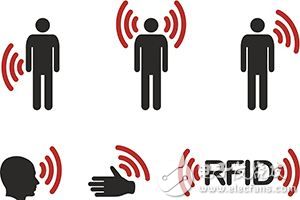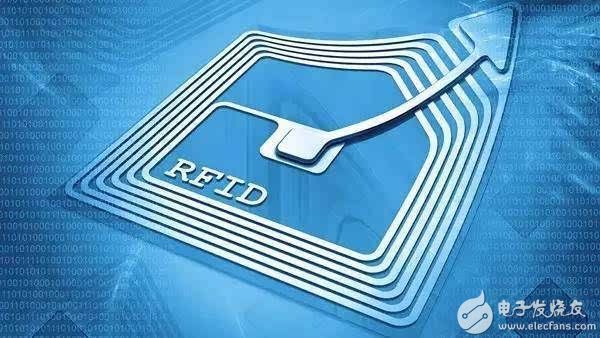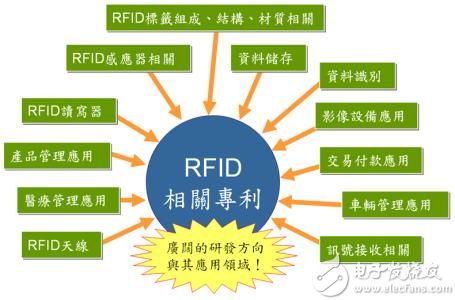Domestically, the development of UHF automatic identification technology has lagged behind the international 2-3 years. Although a number of patented technologies have been formed, the number is small. The core technologies of UHF RFID mainly include: anti-collision algorithm, low-power chip design, UHF electronic tag antenna design, test and certification.

Here we will briefly introduce the patented technologies on UHF RFID!
Low power chip design (low power)
In April 2008, the Chinese invention patent applied by Peking University Shenzhen Graduate School disclosed a demodulation circuit for an ultra-high frequency radio frequency identification chip, including an envelope detection circuit and an envelope shaping circuit. The radio frequency signal received by the antenna sequentially passes through the envelope detection circuit and the envelope shaping circuit and is processed to output the S signal and the Sav signal to the comparator.
The envelope shaping circuit includes a bleeder resistor, a diode, a filter resistor, and a filter capacitor. Wherein, the bleeder resistor is connected between the signal output end of the envelope detecting circuit and the ground; the diode anode is connected to the signal output end of the envelope detecting circuit; and the cathode is connected to one end of the parallel branch formed by the filter resistor and the filter capacitor, and connected in parallel The other end of the branch is grounded.
The signal output end of the envelope detection circuit is the S signal output end, and the connection point of the diode cathode and the parallel branch formed by the filter resistor and the filter capacitor is the Sav signal output end. The invention realizes the coexistence of low power consumption and low cost of the demodulation circuit of the UHF radio frequency identification chip.
Anti-Collision Algorithm
1. In February 2007, the Chinese invention patent applied by Shenzhen Contemporary Communication Technology Co., Ltd. involved a multi-tag anti-collision algorithm in UHF long-distance automatic identification system. The algorithm dynamically adjusts the Q value according to the condition that the label returns data collision, which includes the following steps:
a, the preset Q value is 0 to 15;
b, the reader sends a QUERY command and receives the tag return;
c, the reader sends 2 Q QUERY REP (query response) command;
d. After the steps a, b, and c, the collision count is 0, the label reading process ends; if the collision number is not 0, the Q value of the next QUERY command is determined according to the number of collisions, and steps a, b, and c are repeated. .
The dynamic Q value is determined by the following method:
a. Estimate the quantity value of the label;
b. According to the estimated value of the number of tags and the power-sum exponential operation of the calculated probability, find the base 2 index, which is the new Q value.
The invention can realize the complete and complete reading of the multi-label in the UHF remote automatic identification system and has high reading efficiency.
2. In December 2007, the Chinese invention patent applied by Fudan University disclosed a random anti-collision algorithm combining Bit-Slot and ID-Slot.
First, the tag randomly selects a slot feedback 1-bit acknowledgment command, and the return information of all tags constitutes a string of length L, and the reader sends L-c0 QueryRep commands after the empty slot is eliminated, and the tag is in the time slot. The corresponding time slot of the counter feeds back its own ID code, and the reader determines whether a collision occurs according to the received ID code; the reader recognizes the tag and counts the number of collision time slots and the number of successful time slots; if the tag is not After the identification is completed, the reader then opens the next frame to continue identifying the tags until all the tags are identified.
The invention uses the Bit-slot method to reduce the time overhead of the empty time slot, and uses the shorter QueryRep instruction instead of the longer "unique code" confirmation command in the Bit-Slot, which can effectively improve the multi-tag recognition speed.
3. In August 2003, the Chinese invention patent applied by Shanghai Fudan Microelectronics Co., Ltd. disclosed a method for identifying the anti-collision of the high-frequency radio frequency identification system, which system comprises a reader and at least one transponder. It is characterized in that wireless communication is established between the reader and the transponder using a particular form of wireless signal consisting of a logical signal portion and a time slot portion. The logic signal portion is used to transmit various commands or information from the reader to the transponder, and the time slot portion is used for the transponder to perform backscatter modulation to transmit a one-bit response signal to the reader.
Based on wireless communication, the reader sends the corresponding command or information to the transponder, so that the transponder can perform corresponding conversion between the initial state, the general inquiry state, the general search state, the waiting state, and the confirmation state, and execute the reader to the transponder. Search and query actions to complete the reader's recognition of the transponder.
The invention solves the problem of synchronization of the previous binary search method and improves its anti-interference performance.
4. In December 2008, the Chinese invention patent applied by Shanghai Fudan Microelectronics Co., Ltd. disclosed a multi-label anti-collision algorithm. The algorithm includes: clearing; the reader sends a tag query command; the responder determines the query command received; the reader receives the tag query response and determines; the reader/writer performs data processing on the responder; the pd value is set to 1 The Q value is set to Q; the reader sends a query change command and the responder sends back; the reader receives the tag query response and judges.
The reader performs data processing on the transponder. The algorithm can cycle in a fast elimination manner. It has high actual recognition efficiency for conflicting tags, and can quickly reduce the number of transponders in the reader's working range. Reducing the number of transponders improves recognition efficiency, and on the other hand, it can reduce the interference of the reader in the electromagnetic environment to further improve the recognition quality.

Test certification
In October 2008, the Chinese utility model patent applied by Shanghai Juxing Instrument Co., Ltd. involved a radio frequency identification comprehensive test instrument with real-time response function. It consists of controller, intermediate frequency, baseband processor, RF upconverter and RF downconverter. The output end of the controller is connected to the input end of the intermediate frequency and baseband processor, the output end of the intermediate frequency and baseband processor is connected to the input end of the RF upconverter, the output end of the RF upconverter outputs the signal, and the input end of the RF downconverter is connected. The device returns a signal, and the output of the RF downconverter is connected to the input of the intermediate frequency and baseband processor.
The test instrument is mainly used for protocol conformance test and performance test of card reader and label, realizes radio frequency identification protocol through software, integrates test system exclusively for radio frequency identification test with modular instrument, and uses onboard and baseband processor onboard. The FPGA implements the second-generation UHF radio frequency identification standard microsecond real-time response.

UHF electronic tag antenna design
1. In July 2007, the Chinese invention patent applied by Beijing University of Posts and Telecommunications involved the design of a capacitive and inductively coupled tag antenna consisting of a dielectric substrate and an antenna unit disposed on a dielectric substrate.
The antenna unit includes:
a. The first component, which is an antenna unit body, includes a first conductor and a second conductor, and is composed of a straight line or a bent line for controlling the operating frequency;
b. The second component provides good capacitive coupling for the first component and achieves adjustable antenna capacitance within a certain range;
c. a third component, located in a closed space of the second conductor and the second component of the first component, providing a good inductive coupling of the first component according to its shape and area and relative position within the closed space, and The antenna inductance value within a certain range can be adjusted.
The tag antenna can be impedance-matched with different tag chips by simple adjustment while ensuring sufficient bandwidth in the operating band.
2. In August 2008, the Chinese invention patent applied by Zhejiang University disclosed a dual-band anti-metal UHF RFID tag antenna. The utility model comprises a metal floor, a metal radiating surface, a substrate, a rectangular groove, a first feeding line, a second feeding line, a via hole, a radio frequency identification chip and a U-shaped slit, and the substrate is rectangular. The metal radiating surface is located on the upper surface of the substrate, the metal ground is located on the lower surface of the substrate, and the side of the metal radiating surface adjacent to the short side is embedded with a rectangular groove, and the first feeding line and the second feeding line are arranged in the middle of the rectangular groove, and the first feeding line has one end and the first feeding line A radio frequency identification chip is disposed between one end of the two feeding lines, the other end of the first feeding line is connected with the metal radiating surface, the second feeding line is provided with a through hole, the upper end of the through hole is connected with the second feeding line, and the lower end of the through hole is connected with the metal ground. A pair of U-shaped slits are embedded in the metal radiating surface on both sides of the long side.
The radio frequency identification anti-metal tag made by the antenna can cover two frequency bands of China UHF radio frequency identification or two frequency bands of UHF radio frequency identification in North America and Europe.
3. In November 2008, the Chinese utility model patent filed by Aerospace Information Co., Ltd. disclosed a broadband RFID UHF antenna comprising a near field antenna and a far field antenna combined. The near field antenna is an induction coil, and the far field antenna is a dipole antenna. The antenna is etched onto an aluminum coated polyester PET substrate. At the same time, the utility model also provides a radio frequency tag using the above antenna.
The antenna's working range of the antenna includes a near-field or far-field range, and its operating frequency range covers the entire RFID UHF band, so it has wide adaptability. At the same time, the impedance value is very stable in the frequency band and has good omnidirectionality in the xz direction in the operating frequency band.
4. In September 2005, the Chinese invention patent filed by Samsung TECHWIN Co., Ltd. disclosed a UHF RFID tag and a production method thereof.
The label includes a substrate, a chip attached to the substrate and having a plurality of solder bumps for connecting a circuit formed in the chip and an external circuit, and at least one extending in a longitudinal direction and responding to an ultra-high frequency transmitted from the outside UHF antenna for electromagnetic fields.
Wherein at least one end of the UHF antenna is coupled to the solder bump and a portion of the antenna is secured to the substrate. Since the UHF RFID tag uses a plurality of short UHF antennas instead of the loop antenna, the tag can be integrated as much as possible due to the small volume, and the process of bonding the antenna to the chip can be quickly and easily implemented.
UHF rfid technology has the ability to read multiple tags at one time, has strong penetrability, can read and write multiple times, and has large memory capacity. The passive electronic tag has low cost, small size, convenient use, high reliability and longevity. Features, I believe that the future will be better developed, thus broadening the application field of UHF RFID.
Household Electrical Appliances
gree , https://www.greegroups.com